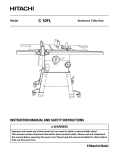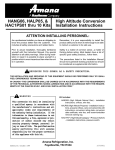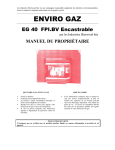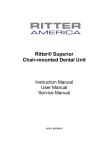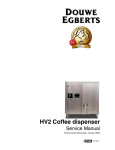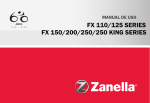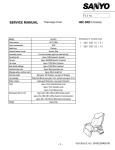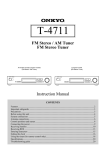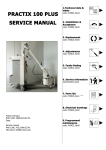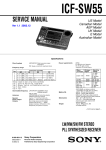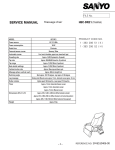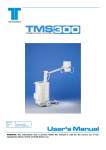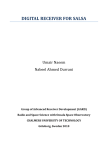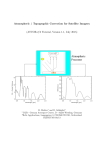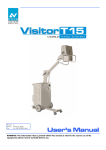Download HEC-DR5000(Service Manual)
Transcript
FILE No. SERVICE MANUAL Chair Type Massager (Massager Lounger) -1- HEC-DR5000 (GENERAL) REFERENCE NO. SM6510488-00 Specifications Power source HEC-DR5000 (GENERAL) AC Local voltage 50/60 Hz Power consumption 290 W 30 minutes Rated time Timer Dimensions (MANUAL COURSE) Approx. 15 minutes (WHOLE BODY SENSOR AUTOMATIC COURSE) Approx. 15 minutes (maximum Approx. 20 minutes) (AUTOMATIC COURSE) Approx. 15 minutes (maximum Approx. 20 minutes) 730 mm[width] x 1,240 mm[depth] x 1,200 mm[height] * When not reclined (with foot rest retracted) 730 mm[width] x 1,940 mm[depth] x 680 mm[height] * When reclined (with foot rest set horizontally) Approx. 70kg Weight Accessories Stand, Installation screws(Three) Exterior cloth Artificial leather 100% Massaging Frequency (5 stages) Approx. 10 times/min., 15 times/min., 20 times/min., 25 times/min., 30 times/min. Tapping Frequency (Upper body) (5 stages) Approx. 300 times/min., 390 times/min., 480 times/min., 540 times/min., 600 times/min. Tapping width (Upper body) Vertical movement speed Backbone stretching width (5 stages) Approx. 70mm, 85mm, 100mm, 115mm, 130mm Vartical movement speed One up/down pass in approx. 35 sec. (5 stages) Approx. 70mm, 85mm, 100mm, 115mm, 130mm Range of partial stretching Range of partial stretching Partial stretching(Long) :Repetition within Approx.200mm Partial stretching(Short) :Repetition within Approx.100mm Massaging balls up/down range Approx. 720 mm Height adjustment of massaging balls Reclining angle Reclining method Lower Body Massaging (Air pressure) No gradation or 2cm/one press of button Approx. 120 - 170 degrees Motor-driven type (Linked with foot rest) Strong: Approx. 27kPa Weak: Approx. 21kPa - 2- * There is a slight difference according to the part. Name/Function of Each Part HEC-DR5000 (GENERAL) Head cover Senser Back rest Remote control Massage hands Stand Back pad Arm rest Seat cover ( 2 Air bags ) Foot rest ( 18 Air bags ) Reclining motors Control unit Air pump & Solenoids Massage unit Tapping motor Massage motor Strength motor Elevation motor LOCK switch OPEN LOCK ON Caster POWER switch Earthing screws (for LOW voltage) OFF POWER Power cord Power plug - 3- Wiring Diagram (for LOW voltage) HEC-DR5000 (GENERAL) CN931 Limit Switch(UPPER) (Strength) Printed board (Strength Pulse) CN904 Volume Rotary (Pressure) CN903 CN902 CN905 Motor(Elevation) CN911 Printed board (Elevation Pulse) Printed board (Massage Pulse) Motor(Strength) Motor(Massage) CN901 Motor(Tapping) CN906 CN921 Printed board (Tapping Pulse) Reclining Motor(Foot Rest) Reclining Motor (Back Rest) Switch Motor Motor Switch Main Harness Transformer Limit SW(UPPER) (Elevation) Reactor CN25 CN24 CN8 CN9 CN10 CN11 CN19 CN23 CN12 CN16 CN13 Printed board(Main) CN15 CN7 CN28 CN20 CN18 CN22 CN4 CN14 Valve (No.1) Printed board(Power) CN3 Valve (No.2) CN5 CN6 CN27 CN1 CN2 CN17 CN21 CN1 Valve (No.3) Thermistor Valve (No.4) Transformer CN703 Printed board (Remote Control) Printed board (Sensor Control) (Remote Control) Heater(Sole) Valve (No.5) Air Pump Power Switch Fuse (250V 4A) CN702 Valve (No.6) Perspiration Sensor CNB701 Valve (No.7) Printed board (Sensor Operation) CNA701 Valve (No.8) CN701 (Sensor) AC -4- CNA791 Printed board (Pulse Sensor) Wiring Diagram (for HIGH voltage) HEC-DR5000 (GENERAL) CN931 Limit Switch(UPPER) (Strength) Printed board (Strength Pulse) CN904 Volume Rotary (Pressure) CN903 CN902 CN905 Motor(Elevation) CN911 Printed board (Elevation Pulse) Printed board (Massage Pulse) Motor(Strength) Motor(Massage) CN901 Motor(Tapping) CN906 CN921 Printed board (Tapping Pulse) Reclining Motor(Foot Rest) Reclining Motor (Back Rest) Motor Switch Motor Switch Main Harness Transformer Limit SW(UPPER) (Elevation) Reactor CN25 CN24 CN8 CN9 CN10 CN11 CN19 CN23 CN12 CN16 CN13 Printed board(Main) CN15 CN7 CN28 CN20 CN18 CN22 CN4 CN14 Valve (No.1) Printed board(Power) CN3 Valve (No.2) CN5 CN6 CN27 CN1 CN2 CN17 CN21 CN1 Valve (No.3) Thermistor Valve (No.4) Transformer CN703 Printed board (Remote Control) Printed board (Sensor Control) (Remote Control) Heater(Sole) Valve (No.5) Valve (No.6) Air Pump Power Switch Fuse (250V 4A) CN702 Valve (No.7) CNB701 Valve (No.8) Printed board (Sensor Operation) CNA701 CN701 AC (Sensor) - 5- Perspiration Sensor CNA791 Printed board (Pulse Sensor) Air Wiring HEC-DR5000 (GENERAL) Air pump compressing decompressing Air tank 1 Air bag (Foot shiatsu, middle) Exhaust 1 Solenoid (Foot shiatsu, middle) 5 Solenoid (Leg pinching) 1 Air bag (Foot shiatsu, middle) Exhaust 2 Solenoid (Foot shiatsu, back and forth) 2 Air bag (Foot shiatsu, back and forth) Exhaust 3 Air bag (Leg shiatsu, upper) 2 Air bag (Foot shiatsu, back and forth) 3 Solenoid (Leg shiatsu, upper) 4 Air bag (Leg shiatsu, lower) 4 Solenoid (Leg shiatsu, lower) 5 Air bag (Leg pinching) Exhaust 6 Solenoid (Foot pinching, outsaide) 6 Air bag (Foot pinching, outsaide) Exhaust 7 Air bag (Foot pinching, insaide) 6 Air bag (Foot pinching, outsaide) 7 Solenoid (Foot pinching, insaide) 3 Air bag (Leg shiatsu, upper) Exhaust 5 Air bag (Leg pinching) Exhaust 7 Air bag (Foot pinching, insaide) 8 Air bag (Thigh, right , left) Exhaust 8 Solenoid (Thigh, right , left) 4 Air bag (Leg shiatsu, lower) 8 Air bag (Thigh, right , left) Air tank 8 8 4 3 5 5 4 5 3 4 2 2 6 1 7 7 1 6 2 2 8 5 3 2 7 1 6 5 Air pump Air bag position Solenoid / Air pump position - 6- Air Massage HEC-DR5000 (GENERAL) Structure of air massaging component for lower extremites Air hoses Air tank 8 8 4 3 5 5 4 1, 2, 3, 4, 5 3 4 2 2 6 1 7 7 1 6 2 2 8 5 3 7 2 1 6 5 Solenoids Air pump Photo-1 Foot shiatsu, middle Foot shiatsu, back and forth Leg shiatsu, upper Leg shiatsu, lower 5, 6, 7, 8, Photo-2 Leg pinching Foot pinching, outsid Foot pinching, insaide Thigh, right, left 1. The air massager is composed of 20 air bags (photo-1) contained in an air pump, an air tank and solenoids (Photo-2), and foot and leg massaging components and of air hoses (photo-2) connecting among them, all of which are located under the seat. 2. Air pressured by means of the air pump is supplied to the individual air bags by switching among the solenoids. 3. In massaging, the process of two steps is repeated; 1) pressing and finger-pressurizing feet and legs by air bags expanded with filled air and 2) compressing the air bags by discharging air from the solenoids. - 7- Massage Motors HEC-DR5000 (GENERAL) 2 2 1 3 3 2,Massage motor 3,Strength motor 4,Elevation motor 1,Tapping motor 4 4 1, Tapping motor This motor rotates to move the massage balls upward and downward alternately via the driving belt coupled to the motor. (The motor revolutions is adjustable in three steps so that the tapping frequency can be changed over to approximately 300,390,480,540 and 600 cycles/minute.) 2, Massage motor This motor rotates to move the massage balls crosswise via the driving belt and gear box coupled to the motor. (The motor revolutions is adjustable in three steps so that the massaging frequency can be changed over to approximately 10,15,20,25 and 30 cycles/minute.) (When tapping, shiatu and stretching the backbone line, the massage ball position can be changed over in three steps after starting the massagemotor.) (Massage ball width approximately 70,85,100,115 and 130 mm.) 3, Strength motor This motor rotates to transmit its rotating torque to the shaft screw via the driving belt, whereby the massage unit is moved forward, and backward and the massage balls is moved forward and backward. (This motor rotates clockwise and counterclockwise to thereby move the massage unit forward and backward.) (When tapping, massage, shiatu and stretching the backbone line, the massage unit position can be changed over in five steps after starting the strength motor.) 4, Elevation motor This motor rotates to transmit its rotating torque to the gear of right and left of a massage unit the driving belt. The gear is included in right and left of a back frame. It has geared with the gear of right and left of a massage unit. This motor rotates, a gear on either side rotates and a massage unit moves up and down in the gear top of a back frame. (This motor rotates, clockwise and counterclockwise to thereby move the massage unit move up and down.) (When stretching the backbone line, the massage ball is moved up and down.) -8- Massage Motors HEC-DR5000 (GENERAL) Shoulder Gripping & Massaging With the aid of a massage hand unit with a joint which moves freely like a thumb, a massaging technique called "Grip/Grasp/Massage/Knead" for gripping and massaging the muscles of shoulders has been reproduced. This massaging technique has been reproduced by way of gripping the shoulders from above while projecting the massage hands greatly together with a massage unit at the back (maximum projection of massage hands: approx. 160mm). Operation of Shoulder Gripping & Massaging There are two large massage hands and two small massage hands at both ends of the right and left massage arms. The small massage hands have the structure to move freely. The massage hands move from side to side according to the operation of massage motors. When the distance between the massage hands becomes narrower (the massage hands move inwards), the massage hands move so that the clearance between the large massage hands and the small massage hands becomes narrower. Operation of shoulder gripping and massaging: Shoulder position is first measured, and the massage hands project forward greatly only at the shoulder position and "grip and massage the shoulders". *The "shoulder gripping and massaging" function does not work on the back or the waist. Large massage hands Small massage hands Narrow massage hands Wide massage hands -9- Operation of Stiffness Detecting Sensor HEC-DR5000 (GENERAL) The sensor employs two types of sensors; an photo sensor and an electrical skin resistance sensor for monitoring two physiological factors (pulse rate and perspiration respectively). If stiffened position is subjected to stimulation of massage, the pulse rate and perspiration will change accordingly. The sensor monitors such change in those two factors. Sensor Detection A stimulation given to the stiffened or sore muscle will cause vital reaction considered to represent a change in sensation such as better feeling with comfortable pains. Monitoring such vital reaction (perspiration and/or change in pulse rate) concurrently enables determination of the effectiveness of the stimulation given. Perspiration Pulse rate When stimulated and felt "stiffened" Perspiration Pulse rate increases increases STIFFNESS The stiffness determined by a change in perspiration and RELAX HIGHT pulse rate monitored will be indicated in real time on a level Stiffness display Indicates stiffness in real time by meter of a remote controller. monitoring fingers for any change 1;When relaxed, the perspiration tends to decrease. in perspiration and pulse rate during acupressure massage. 2;When in normal condition, each physiological parameter shows less change. 3;When felt stiffened, the perspiration as well as pulse rate tends to increase. 4;When feeling a pain, the perspiration significantly increases and the pulse rate tends to increase. In the massage position display, the position where stiffness is detected (=the point needs to be massaged) will be displayed. Point that may be massaged. STIFFNESS Massage position display Position where stiffness is detected Indicates positions where the sensor detects stiffness by monitoring perspiration and pulse rate that will change when better feeling is given through stimulation by massage. - 10 - Operation of Body Contour Sensor HEC-DR5000 (GENERAL) Detects a pressure applied to the massasing balls for automatic adjustment to their best position. Detects a pressure applied to the massasing balls for measuring spine curving to find out body contour and shoulder position. Corrects the positions automatically if the posture varies when reclining a seat. (When the shoulder position is being adjusted, the "SHOULDER" display of the remote controller turns ON with the "UP( )/DOWN ( )" display kept blinking. Adjustment is finished when the "Shoulder Set" lamp turns ON, which will then turn OFF after the shoulder position adjustment is completed.) Detects pressure applied to the massaging balls that depends on spine curving, and determined its body contour and shoulder position. * Unless the massaging balls receive a body weight pressure from user for a certain time during sensor automatic course or automatic course, the operation will discontinue with the massaging balls retracted. - 11 - Error message indication (in Service Mode) HEC-DR5000 (GENERAL) *Abnormal indications detected during operation are stored in a memory up to seven. Seven abnormal indications stored can be confirmed in the service mode (Older indications than the seven abnormal indications will be deleted sequentially). To change over to the service mode, turn ON the POWER switch at the rear of the massager while simultaneously pressing the OPERATION ON/OFF on a remote controller. When the "FINE" button is pressed three times with the OPERATION ON/OFF kept pressed, the massager is placed in the service mode. (When the massager is placed in the service mode, four blue lamps at the WHOLE BODY SENSOR AUTOMATIC COURSE come on). To reset the service mode, turn OFF the POWER switch. OPEN LOCK ON OFF POWER POSITION ADJUST "UP" "DOWN" button "OPERATION ON/OFF" button POWER switch "ON" "FINE" button (three times) When the massager is placed in the service mode, the latest abnormal indication is displayed. The POSITION ADJUST " (UP)" button of the remote controller is used to display older abnormal indications one by one, and " (DOWN)" to display newer abnormal indication one by one (Following the sixth older (the oldest) indication, the latest indication is displayed again). Up to seven abnormal indications are stored in a memory. In case of less than seven, since there are not any abnormal indications, some of the seven STIFFNESS indicators are lit alternatively to indicate the state that abnormalities are not stored. Latest abnormality "UP" Next older abnormality "UP" The oldest abnormality Second older abnormality "DOWN" "DOWN" "DOWN" "UP" "DOWN" Fifth older abnormality "UP" "UP" "DOWN" "DOWN" Fourth older abnormality "UP" STIFFNESS - 12 - RELAX "DOWN" "UP" <Resetting Procedure of Abnormal Indication Memory> Simultaneously press both POSITION ADJUST "UP" and "DOWN" buttons on the remote controller to delete all abnormal indication memory (When the seven STIFFNES indicators are all lit up, all abnormal indication memory have been deleted). All abnormal indication memory have been deleted Third older abnormality HIGHT POWER REMOTE CONTROL - 13 SENSER Troubled phenomenon Nothing is displayed after the power ON. Check item Counteraction method 1. Check the current fuse for fusion. 2. Check the Printed board (Power) CN1 output (AC100V). 3. Check the Printed board (Power) CN6 output (AC100V). 4. Check the Printed board (Main) CN7 output (AC100V). 5. Check the Printed board (Main) CN16 output (approx. AC24V). 6. Check the Printed board (Main) CN21 for connector come-off. 7. Check the Printed board (Remote control) CN1 for connector come-off. 8. Check the Connector (remote control) for disconnection or shorting. 9. Others. Replace the current fuse. Check the power switch and power cord. Check the Printed board (Power). Check the Connector (Printed board) . Replace the transfomer. Insert the connector. Insert the connector. It displays after [ remote control communication impossible ] 3 seconds. (When Printed board (Main) detects) 1. The connection confirmation of Printed board (Main) CN21. 2. The connection confirmation of Printed board (Remote control) CN1. 3. Check the Connector (Remote control) for disconnection or shorting. 4. Others. It displays after [ remote control communication impossible ] 3 seconds. (When Printed board (Remote control) detects) 1. The connection confirmation of Printed board (Main) CN21. 2. The connection confirmation of Printed board (Remote control) CN1. 3. Check the Connector (Remote control) for disconnection or shorting. 4. Others. It displays after [ sensor communication impossible ] 3 seconds. (When Printed board (Main) detects) 1. The connection confirmation of Printed board (Main) CN22. 2. The connection confirmation of Printed board (Sensor ) CN703. 3. Check the Connector (Sensor) cable for disconnection or shorting. 4. Others. It displays after [ sensor communication impossible ] 3 seconds. (When Printed board (Senser) detects) 1. The connection confirmation of Printed board (Main) CN22. 2. The connection confirmation of Printed board (Sensor control) CN703. 3. Check the Connector (Sensor) cable for disconnection or shorting. 4. Others. Indication does not disappear. "Grip the Sensor" 1. The connection confirmation of Printed board (Sensor )CN701, CN702. Replace the Connector (Remote control) . Replace the Printed board (Remote control) or Printed board (Main). Insert the connector. Insert the connector. Problem Diagnosis Chart Troubled portion Error message Replace the Connector (Remote control) . Replace the Printed board (Remote control) or Printed board (Main). Insert the connector. Insert the connector. Replace the Connector (Remote control) . Replace the Printed board (Remote control) or Printed board (Main). Insert the connector. Insert the connector. Replace the Connector (Sensor) . Replace the Printed board (Sennsor ) or Printed board (Main). Insert the connector. Insert the connector. Replace the Connector (Sensor) . Insert the connector. *Be sure to grip the sensor. *When the user's skin is gry (espeially a person with dry skin), yhe degree of stiffness may not be measured correctly. In such a case, slightly moisten with the fingers using hand cream. HEC-DR5000 (GENERAL) Replace the Printed board (Sennsor ) or Printed board (Main). MASSAGE *When there is not output level at sensor(IC902) for continuation 30 seconds while Massage motor are getting erectricity. - 14 - *When there is no output at sensor (IC902) for continuation 15 seconds while Massage motor are getting erectricity. TAPPING Troubled phenomenon Check item Counteraction method Massage mode doesn't move. 1. The connection confirmation of Printed board (Main) CN9 and the junction connector. 2. The connection confirmation of Printed board (Main) CN19 and Printed board (Massage pulse) CN901. 3. Check the Printed board (Main) CN9 output (approx. DC60 - 100V). Insert the connector. A stop of massaging motion can not be carried out. 1. The connection confirmation of Printed board (Main) CN19 and Printed board (Massage pulse) CN901. 2. Check turning on confirmation main harness. 3. Check the magnet in a Holder (magnet width) . 4. Check the Printed board (Massage pulse) IC902 for inclination. Insert the connector. If output Replace the massage motor. If no output Replace the Printed board (Main). Insert the connector. Replace the main harness. The magnet position correction for the detection. Correct the tilted condition or replace the Printed board (Massage pulse). Massage motor rotation. 1. Check the massage motor belt for dislocation and cut-off. The massage motor belt correction, the exchange. Massage mode doesn't move. 1. The connection confirmation of Printed board (Main) CN9 and the junction connector. 2. The connection confirmation of Printed board (Main) CN19 and Printed board (Massage pulse) CN901. 3. Check the Printed board (Main) CN7 output (approx. DC60 - 100V). Insert the connector. A stop of massaging motion can not be carried out. 1. The connection confirmation of Printed board (Main) CN19 and Printed board (Massage pulse) CN901. 2. Check turning on confirmation main harness. 3. Check the magnet in a pulley (massage) . 4. Check the Printed board (Massage pulse) IC901 for inclination. Insert the connector. If output Replace the massage motor. If no output Replace the Printed board (Main). Insert the connector. Replace the main harness. The magnet position correction for the detection. Correct the tilted condition or replace the Printed board (Massage pulse). Massage motor rotation. 1. Check the massage motor belt for dislocation and cut-off. The massage motor belt correction, the exchange. Tapping mode doesn't move. 1. The connection confirmation of Printed board (Main) CN8 and the junction connector. 2. Check the Printed board (Main) CN8 output (approx. DC60 - 100V). Insert the connector. *When there is no output†at sensor (IC921) for continuation 15 seconds while tapping motor are getting erectricity. Tapping motor rotation. If output Replace the tapping motor. If no output Replace the Printed board (Main). 1. The connection confirmation of Printed board (Main) CN19 and Printed board (Massage pulse) CN901 and CN906. 2. Check turning on confirmation main harness. 3. The magnet check for the tapping detection. Insert the connector. 1. Check the tapping motor belt for dislocation and cut-off. The tapping motor belt correction, the exchange. Replace the main harness. The magnet position correction for the detection. 4. Check the Printed board (Tapping pulse) IC921 for inclination. Correct the tilted condition or replace the Printed board (Tapping pulse). HEC-DR5000 (GENERAL) A stop of tapping motion can not be carried out. Problem Diagnosis Chart Troubled portion Error message STRENGTH When there is no detection of lower limit position for continuation 15 seconds while strength motor are moving downward way. When there is no detection of upper limit position for continuation 15 seconds while strength motor are moving upper ward way. Troubled phenomenon Check item Counteraction method A stop of strength motion can not be carried out. 1. The connection confirmation of Printed board (Main) CN19 and Printed board (Massage pulse) CN901 and CN902. The connection confirmation of Printed board (Strength pulse) CN931. 2. Check turning on confirmation main harness. 3. The magnet check for the strength detection. Insert the connector. 4. Check the Printed board (Strength pulse) IC931, IC932 for inclination. Strength motor rotation. 1. Check the strength motor belt for dislocation and cut-off. The elevation motor belt correction, the exchange. A stop of strength motion can not be carried out. 1. The connection confirmation of Printed board (Massage pulse) CN904 2. Check the limit switch(strength). 3. Others. Insert the connector. Strength motor rotation. 1. Check the strength motor belt for dislocation and cut-off. The strength motor belt correction, the exchange. A stop of strength motion can not be carried out. 1. The connection confirmation of Printed board (Main) CN19 and Printed board (Massage pulse) CN901 and CN902. The connection confirmation of Printed board (Strength pulse) CN931. 2. Check turning on confirmation main harness. 3. The magnet check for the strength detection. Insert the connector. - 15 When there is not output level at sensor for continuation 15 seconds while strength motor are getting erectricity. 4. Check the Printed board (Strength pulse) IC931, IC932 for inclination. Replace the switch(strength). Replace the Printed board (Main). Replace the main harness. The magnet position correction for the detection. Correct the tilted condition or replace the Printed board (Strength pulse). Strength motor rotation. 1. Check the strength motor belt for dislocation and cut-off. The strength motor belt correction, the exchange. Strength mode doesn't move. 1. The connection confirmation of Printed board (Main) CN10 and the junction connector. 2. Check the Printed board (Main) CN10 output (approx. DC60 - 100V). Insert the connector. A stop of strength motion can not be carried out. 1. The connection confirmation of Printed board (Main) CN19 and Printed board (Massage pulse) CN901 and CN902. The connection confirmation of Printed board (Strength pulse) CN931. 2. Check turning on confirmation main harness. 3. The magnet check for the strength detection. 4. Check the Printed board (Strength pulse) IC931, IC932 for inclination. Strength motor rotation. 1. Check the strength motor belt for dislocation and cut-off. If output Replace the strength motor. If no output Replace the Printed board (Main). Insert the connector. Replace the main harness. The magnet position correction for the detection. Correct the tilted condition or replace the Printed board (Strength pulse). The strength motor belt correction, the exchange. HEC-DR5000 (GENERAL) When there is not output level at sensor for continuation 15 seconds while strength motor are getting erectricity. Replace the main harness. The magnet position correction for the detection. Correct the tilted condition or replace the Printed board (Strength pulse). Problem Diagnosis Chart Troubled portion Error message ELEVATION When there is no detection of lower limit position for continuation 30 seconds while elevation motor are moving downward way. When there is no detection of upper limit position for continuation 30 seconds while elevation motor are moving upper ward way. - 16 When there is not output level at sensor(IC912) for continuation 30 seconds while elevation motor are getting erectricity. Check item Counteraction method A stop of elevation motion can not be carried out. 1. The connection confirmation of Printed board (Main) CN19 and Printed board (Massage pulse) CN901 and CN905. The connection confirmation of Printed board (Elevation pulse) CN911. 2. Check turning on confirmation main harness. 3. The magnet check for the elevation detection. Insert the connector. 4. Check the Printed board (Elevation pulse) IC912 for inclination. Replace the main harness. The magnet position correction for the detection. Correct the tilted condition or replace the Printed board (Elevation pulse). Elevation motor rotation. 1. Check the elevation motor belt for dislocation and cut-off. The elevation motor belt correction, the exchange. A stop of elevation motion can not be carried out. 1. The connection confirmation of Printed board (Main) CN23 Insert the connector. 2. Check the limit switch(elevation). 3. Others. Replace the switch(elevation). Replace the Printed board (Main). Elevation motor rotation. 1. Check the elevation motor belt for dislocation and cut-off. The elevation motor belt correction, the exchange. A stop of elevation motion can not be carried out. 1. The connection confirmation of Printed board (Main) CN19 and Printed board (Massage pulse) CN901 and CN905. The connection confirmation of Printed board (Elevation pulse) CN911. 2. Check turning on confirmation main harness. 3. The magnet check for the elevation detection. Insert the connector. 4. Check the Printed board (Elevation pulse) IC912 for inclination. Replace the main harness. The magnet position correction for the detection. Correct the tilted condition or replace the Printed board (Elevation pulse). Elevation motor rotation. 1. Check the elevation motor belt for dislocation and cut-off. The elevation motor belt correction, the exchange. Elevation mode doesn't move. 1. The connection confirmation of Printed board (Main) CN11 and the junction connector. 2. Check the Printed board (Main) CN11 output (approx. DC60 - 100V). Insert the connector. A stop of elevation motion can not be carried out. 1. The connection confirmation of Printed board (Main) CN19 and Printed board (Massage pulse) CN901 and CN905. The connection confirmation of Printed board (Elevation pulse) CN911. 2. Check turning on confirmation main harness. 3. The magnet check for the elevation detection. 4. Check the Printed board (Elevation pulse) IC911 for inclination. Elevation motor rotation. 1. Check the elevation motor belt for dislocation and cut-off. If output Replace the elevation motor. If no output Replace the Printed board (Main). Insert the connector. Replace the main harness. The magnet position correction for the detection. Correct the tilted condition or replace the Printed board (Elevation pulse). The elevation motor belt correction, the exchange. HEC-DR5000 (GENERAL) When there is not output level at sensor(IC911) for continuation 30 seconds while elevation motor are getting erectricity. Troubled phenomenon Problem Diagnosis Chart Troubled portion Error message Troubled phenomenon Check item Counteraction method RECLINING BACK REST The back rest reclining motion doesn't move. (Don't up) 1. The connection confirmation of Printed board (Power) CN4. 2. Check the Printed board (Power) CN4 output (approx. DC100V). Insert the connector. If output Replace the reclining motor (back rest). If no output Replace the Printed board (Power). A back rest lilacinning operation stop is not carried out. 1. The connection confirmation of Printed board (Main) CN24. 2. Check the back rest reclining upper limit switch. 3. Others. Insert the connector. Replace the reclining motor (back rest). Replace the Printed board (Main). The back rest reclining motion doesn't move. (Don't down) 1. The connection confirmation of Printed board (Power) CN4. 2. Check the Printed board (Power) CN4 output (approx. DC100V). Insert the connector. If output Replace the reclining motor (back rest). If no output Replace the Printed board (Power). When there is no detection of reclining switch(upper limit) at the back part for continuation 1 minutes while reclining motor are moving for raising seat. - 17 - When there is no detection of reclining switch(lower limit) at the back part for continuation 1 minutes while reclining motor are moving for lower seat. When there is detection of reclining switch(upper limit) at the back part for continuation 1 minutes while reclining motor are moving for lower seat. Insert the connector. Replace the reclining motor (back rest). Replace the Printed board (Main). The back rest reclining motion doesn't move. (Don't down) 1. The connection confirmation of Printed board (Power) CN4. 2. Check the Printed board (Power) CN4 output (approx. DC100V). Insert the connector. If output Replace the reclining motor (back rest). If no output Replace the Printed board (Power). A back rest lilacinning operation stop is not carried out. 1. The connection confirmation of Printed board (Main) CN24. 2. Check the back rest reclining upper limit switch. 3. Others. Insert the connector. Replace the reclining motor (back rest). Replace the Printed board (Main). The back rest reclining motion doesn't move. (Don't up) 1. The connection confirmation of Printed board (Power) CN4. 2. Check the Printed board (Power) CN4 output (approx. DC100V). Insert the connector. If output Replace the reclining motor (back rest). If no output Replace the Printed board (Power). A back rest lilacinning operation stop is not carried out. 1. The connection confirmation of Printed board (Main) CN24. 2. Check the back rest reclining lower limit switch. 3. Others. Insert the connector. Replace the reclining motor (back rest). Replace the Printed board (Main). HEC-DR5000 (GENERAL) When there is detection of reclining switch(lower limit) at the back part for continuation 1 minutes while reclining motor are moving for raising seat. A back rest lilacinning operation 1. The connection confirmation of Printed board (Main) CN24. 2. Check the back rest reclining lower limit switch. stop is not carried out. 3. Others. Problem Diagnosis Chart Troubled portion Error message Check item Counteraction method RECLINING FOOT REST The foot rest reclining motion doesn't move. (Don't up) 1. The connection confirmation of Printed board (Power) CN5. 2. Check the Printed board (Power) CN5 output (approx. DC100V). Insert the connector. If output Replace the reclining motor (foot rest). If no output Replace the Printed board (Power). A foot rest lilacinning operation stop is not carried out. 1. The connection confirmation of Printed board (Main) CN25. 2. Check the foot rest reclining upper limit switch. 3. Others. Insert the connector. Replace the reclining motor (foot rest). Replace the Printed board (Main). The foot rest reclining motion doesn't move. (Don't down) 1. The connection confirmation of Printed board (Power) CN5. 2. Check the Printed board (Power) CN5 output (approx. DC100V). Insert the connector. If output Replace the reclining motor (foot rest). If no output Replace the Printed board (Power). A foot rest lilacinning operation stop is not carried out. 1. The connection confirmation of Printed board (Main) CN25. 2. Check the foot rest reclining lower limit switch. 3. Others. Insert the connector. Replace the reclining motor (foot rest). Replace the Printed board (Main). The foot rest reclining motion doesn't move. (Don't down) 1. The connection confirmation of Printed board (Power) CN5. 2. Check the Printed board (Power) CN5 output (approx. DC100V). Insert the connector. If output Replace the reclining motor (foot rest). If no output Replace the Printed board (Power). A foot rest lilacinning operation stop is not carried out. 1. The connection confirmation of Printed board (Main) CN25. 2. Check the foot rest reclining upper limit switch. 3. Others. Insert the connector. Replace the reclining motor (foot rest). Replace the Printed board (Main). The foot rest reclining motion doesn't move. (Don't up) 1. The connection confirmation of Printed board (Power) CN5. 2. Check the Printed board (Power) CN5 output (approx. DC100V). Insert the connector. If output Replace the reclining motor (foot rest). If no output Replace the Printed board (Power). A foot rest lilacinning operation stop is not carried out. 1. The connection confirmation of Printed board (Main) CN25. 2. Check the foot rest reclining lower limit switch. 3. Others. Insert the connector. Replace the reclining motor (foot rest). Replace the Printed board (Main). When there is no detection of reclining switch(upper limit) at the foot part for continuation 1 minutes while reclining motor are moving for raising seat. - 18 - When there is no detection of reclining switch(lower limit) at the foot part for continuation 1 minutes while reclining motor are moving for lower seat. When there is detection of reclining switch(upper limit) at the foot part for continuation 1 minutes while reclining motor are moving for lower seat. When there is detection of reclining switch(lower limit) at the foot part for continuation 1 minutes while reclining motor are moving for raising seat. HEC-DR5000 (GENERAL) Troubled phenomenon Problem Diagnosis Chart Troubled portion Error message HERTER Troubled phenomenon When there is thermistor output of continuation 2 second and more then 4.9V. Check item Counteraction method 1. The connection confirmation of Printed board (Main) CN20. Insert the connector. Replace the Connector ass'y (heater). Replace the heater(sole). Replace the Printed board (main). 2. Check the Connector ass'y (heater) for disconnection. 3. Check the Thermistor for disconnection. 4. Others. PRESSURE SENSOR - 19 - When there is thermistor output 1. The connection confirmation of Printed board (Main) CN20. 2. Check the Connector ass'y (heater) for shorting. of continuation 2 second and less then 0.1V. 3. Check the Thermistor for shorting. 4. Others. Insert the connector. Replace the Connector ass'y (heater). Replace the heater(sole). Replace the Printed board (main). 1. Check the volume rotary (pressure) . When there is pressure sensor output of Continuation 3 second (CN903 red-black approx. 10k /red-white approx. and less then 0.1V. 250 - 10k ) 2. The connection confirmation of Printed board (Main) CN19 and Printed board (Massage pulse) CN901 and CN903. Replace the volume rotary (pressure). 8. Check the main harness for disconnection or shorting. Problem Diagnosis Chart Troubled portion Error message Insert the connector. Replace the main harness. Replace the Printed board (main). 4. Others. OTHERS An abnormal power supply. Replace the Printed board (main). 1. Check the power supply of an power point. 2. Others. Replace the Printed board (main). HEC-DR5000 (GENERAL) An abnormal power supply. 1. Check the power supply of an power point. 2. Others. Air-Bag Operation Confirmation Procedure HEC-DR5000 (GENERAL) Start-up of Examination Mode Turn ON the POWER switch at the rear of the massager while simultaneously pressing the POSITION ADJUST "UP" and "DOWN" buttons on the remote controller (This operation should be started with the POWER switch turned OFF). When the examination mode is started up, both a backrest and a foot rest move slightly and come to a stop. LOWER BODY STRENGTH adjusting button OPEN LOCK ON OFF (Simultaneously press) POSITION ADJUST "UP" and "DOWN" buttons POWER POWER switch "ON" Air-Bag Operation Confirmation Press either "WEAK" or "STRONG" button of the LOWER BODY STRENGTH adjustment on the remote controller. Check if the air-bag inflates sequentially as shown below. * If there are any problems, check air leakage, breakage of air hoses, and the air-bag. 1, Foot pinching, outside 2, Foot pinching, inside 8 8 3, Foot shiatsu, middle 4, Foot shiatsu, back and forth 7 5 5 6 5 7 6 5, Leg pinching, inside, outside 5 6, Leg shiatsu, lower 4 4 1 3 2 2 3 1 4 4 7, Leg shiatsu, upper 8, Thigh, right, left - 20 - Replacement Procedure HEC-DR5000 (GENERAL) (1) Replacement of PCBs (main) & (power) 1, Take off four thread caps on an arm rest (left). Photo-1 2, Remove four set screws on the elbow rest and take off the arm rest (left). Photo-1 5, Remove two cover (PCB) set screws and take off latches of ribs at the rear of the cover. Photo-3 Cover (PCB) Arm rest (left) Cover (PCB) set screws Photo-3 Arm rest set screws Thread caps Photo-1 3, Lift up a foot rest and insert a screwdriver and so forth into a link to fix the link. Photo-2 4, Remove four cover (under front) set screws and take off the cover (under front). Photo-2 Driver, etc Cover (under front) 6, Disconnect connectors connected to the PCB (power). Photo-4 7, Unfix seven stoppers (PCB) and take off the PCB (power). Photo-4 8, Remove three stay (PCB) set screws and take off the stay (PCB). Photo-4 * There is a set screw around under a reclining motor at the left side. 9, Disconnect the connectors connected to the PCB (main). Photo-4 10, Unfix nine stoppers (PCB) from the bottom side of the massager and take off the PCB (main). Photo-4 PCB (power) Stoppers Cover set screws Photo-2 PCB (main) Stay (PCB) set screws - 21 - Photo-4 Replacement Procedure HEC-DR5000 (GENERAL) (2) Replacement of Solenoid 1, Remove one cord holder set screw and unfix two remote controller cords. Photo-5 2, Take off four thread caps on the arm rest (right). Photo-5 3, Remove four elbow rest set screws and take off the arm rest (right). Photo-5 Insulator Solenoid Stay (valve) set screw Arm rest (right) Cord holder Cover(Air pump) set screws Photo-6 (3) Replacement of Air Pump, Transformer Reactor Arm rest set screws Thread caps Photo-5 4, Disconnect each air hose. *When taking off the air hoses, indicate a mark such as number, symbol (Exercise care so as not to make a mistake in connecting the hoses). 5, Remove the cord processing of a solenoid (upper step). Photo-6 6, Remove two solenoid (upper step) set screws and take off the solenoid (upper step). Photo-6 7, Remove two stay (valve) set screws and take off the stay (valve). * There are screws behind an insulator on the left side surface. Photo-6 8, Remove the cord processing of a solenoid (lower step). Photo-6 9, Remove two solenoid (lower step) set screws and take off the solenoid (lower step). Photo-6 1, Remove two cover(air pump) set screws and take off the cover(air pump). Photo-6 2, Take off the cord processing of an air pump. 3, Remove four fixing rubbers of the air pump and take off the air pump. Photo-7 4, Take off the cord processing of a transformer. 5, Remove two transformer set screws and take off the transformer. Photo-7 6, Take off the cord processing of a reactor. 7, Remove two reactor set screws and take off the reactor. Photo-7 - 22 - Transformer Reactor Set screws Set screws Air pump Photo-7 Replacement Procedure HEC-DR5000 (GENERAL) (4) Replacement of Reclining Motor (5) Replacement of Power Switch and Current Fuse 1, Take off the arm rest (left). Photo-1 2, Take off the arm rest (right). Photo-5 3, Disconnect each cord processing and cords. 4, Lay down the massager with its left side facing downward. Photo-8 1, Take off the arm rest (right). Photo-5 2, Remove each cord processing and disconnect the cords. 3, Remove two case (switch box) set screws and take off the case (switch box). Photo-10 Case (switch box) Connector (sensor) Connector (remote control) Photo-8 Case set screws 5, Each reclining motor (set) is fixed at two places on both ends. Therefore, remove E rings on both ends and pull out fixing pins. Photo-9 Photo-10 4, Open a fuse case of current fuses and take out a current fuse. Photo-11 5, Remove two switch holder set screws and take off a switch holder. Photo-11 6, Remove a switch fixing screw and take off the POWER switch. Photo-11 Reclining motor (back rest) E rings & fixing pins POWER switch Switch holder set screws Reclining motor (foot rest) Reclining motor (back rest) Reclining motor (foot rest) Power cord Current fuse Photo-11 E rings & fixing pins Photo-9 - 23 - Replacement Procedure HEC-DR5000 (GENERAL) (6) Replacement of Remote Control (7) Replacement of Sensor 1, Remove each cord processing and disconnect the cords. 2, Remove nine remote control case set screws and take off a remote control case (lower). Photo-12 1, Remove each cord processing and disconnect the cords. 2, Remove two sensor case set screws and take off a sensor case (upper). Photo-14 Remote control case set screws Sensor case (upper) Sensor case set screws Remote control case (lower) Photo-14 Photo-12 3, Remove two PCB (remote control) set screws and take off the PCB (remote control) Photo-13 4, Disconnect the interconnecting connector CN1 of the connector (remote control). Photo-13 3, Remove one PCB (sensor) set screw and take off the PCB (sensor). Photo-15 4, Disconnect the interconnecting connector CN703 of the connector (sensor). Photo-15 PCB (remote control) PCB (sensor) PCB set screws PCB set screw Connector(sensor) CN703 Connector (remote control) CN1 Photo-15 Photo-13 - 24 - Replacement Procedure HEC-DR5000 (GENERAL) (8) How to Remove A Massage Unit 1, Remove four cover(back cover) set screws and take off a cover(back cover). Photo-16 If the massage unit does not move upwards when the power is turned on, turn a pulley (elevation) clockwise to move the massage unit to the top position. Photo-17 Cover(back cover) Cover(back cover) set screws Photo-16 2, Move the massage unit upwards to its top position. Usually the massage unit is at a stop at its top position. When the massage unit is at a stop halfway, however, turn on the power and make the massage unit move up to its top position. At the top position, when the massage unit comes to a stop, pull out a POWER plug. Photo-17 Massage unit 3, Remove the cord processing of the cord (main) and disconnect the connectors (four connectors for motors, one for signal line). Photo-18 Remove one earthing set screw and cut eight insulation lock black cords. * Cut the cords with a nipper so that the cords do not get scratched. * In order to restore the wiring processing after reassembling the massage unit, indicate a markon the cords before disconnecting the wiring. 4, Remove one spring A (harness main) set screw and take off a spring A (harness main). Photo-18 5, Remove two screws(stopper) inside of a back frame. Photo-18 6, Turn the pulley (massage) clockwise to minimize the massage hand width. Photo-18 7, Turn the pulley (strength) counterclockwise to bring to minimum position (maximum strength) of a thread bar. Photo-18 Screw (stopper) Moving upwards Pulley (massage) Pulley (strength) Spring A(main harness ) Pulley (elevation) Connector (main) POWER switch Photo-17 Spring A(main harness ) * While the massage unit is moving upwards, exercise care so as not to come into contact with the operating portion. Connector ass'y (main) - 25 - Photo-18 Replacement Procedure HEC-DR5000 (GENERAL) (9) How to Reassemble the Massage Unit 1, Tape a lever of a micro switch. For the purpose of preventing the lever of the micro switch from being deformed or damaged by incidentally hitting it when installing the massage unit. * After installing the massage unit, peel the tape. Photo-21 8, Turn the pulley (evevation) clockwise, move the massage unit upwards, and take off a driving wheel from a back frame guide. Photo-19 * When taking off the driving wheel, hold the massage unit firmly. Driving wheel Tape the lever to protect it. Pulley (evevation) Micro switch Move upwards Photo-21 Photo-19 9, With a guide roller removed, further turn the pulley (evevation) clockwise. Photo-20 10, When right and left gears are disengaged from the back frame gears (rack), take off the massage unit from the massager body. Photo-20 2, Before fitting the massage unit into the massager body, minimize massage hand width by turning the pulley (massage) clockwise. Turn the pulley (strength) counterclockwise to bring to minimum position (maximum strength) of a thread bar. Photo-22 Pulley (strength) Pulley (massage) Gears Photo-22 3, Fit the massage unit in parallel so that the first right and left gear (rack) teeth engage with the right and left gears of the massage unit simultaneously. Photo-22 Pulley (evevation) Photo-20 - 26 - Replacement Procedure HEC-DR5000 (GENERAL) (10) Replacement of PCB (strength pulse) (12) Replacement of PCB (Massage) 1, Disconnect the connector CN931 of the PCB (strength pulse). Photo-23 2, Remove one PCB (strength pulse) set screw and take off the PCB (strength pulse). Photo-23 1, Disconnect five PCB (massage) connectors. Photo-25 2, Remove two PCB (massage) set screws and Photo-25 take off the PCB (massage). Belt (massage) Motor set screws PCB (strength pulse) PCB set screw Motor set screws PCB set screw PCB (massage pulse) Photo-25 Motor (massage) Motor (strength) (13) Replacement of Motor (Massage) Belt(strength) Photo-23 (11) Replacement of Motor (strength) 1, Remove each cord processing. 2, Remove two stay (under the motor (strength)) set screws. Photo-24 3, Disconnect the belt (strength). Photo-23 4, Remove two motor (strength) set screws and take off the motor (strength) and the stay (under the motor (strength)). Photo-23, 24 5, Remove two motor (strength) set screws and take off the motor (strength). * Exercise care so as not to adhere grease to the driving portions such as belt (Failure to observe this precaution may lead to malfunction due to slippage). 1, Remove each cord processing. 2, Disconnect the belt (massage). Photo-25 3, Remove two motor (massage) set screws. Photo-25 4, Remove two stay (under the motor (massage)) set screws and take off the motor (massage). and the stay (under the motor (massage)). Photo-26 5, Remove one motor (massage) set screw and take Photo-26 off the motor (massage). * Exercise care so as not to adhere grease to the driving portions such as belt (Failure to observe this precaution may lead to malfunction due to slippage). Motor (massage) Motor (strength) Motor set screw Stay set screw Stay set screw Stay (under the Motor (strength)) Stay (under the massage motor) Photo-24 - 27 - Photo-26 Replacement Procedure HEC-DR5000 (GENERAL) (14) Replacement of PCB (Tapping pulse) and PCB(elvation pulse) 4, Disconnect the belt (elevation). 1, Disconnect the connector CN921 of the PCB (tapping pulse). Photo-27 2, Remove one PCB (tapping pulse) set screw and take off the PCB (tapping pulse). Photo-27 3, Disconnect the connector CN911 of the PCB (elevation pulse). Photo-27 4, Remove two PCB (elevation pulse) set screws and take off the PCB (elevation pulse). Photo-27 Photo-29 5, Remove two gear box (elevation) set screws, slide the gear box outwards, and turn it clockwise as shown in Photo-30. Photo-29, 30 6, Remove two stay motor (elevation) set screws. Photo-29 Motor (elevation) Stay (Motor (elevation)) PCB set screws Stay set screw Belt (elevation) PCB (tapping pulse) Gear box set screw Photo-29 PCB (elevation pulse) PCB set screw 7, Remove two motor (elevation) set screws and take off the motor (elevation). Photo-30 * Exercise care so as not to adhere grease to the driving portions such as belt (Failure to observe this precaution may lead to malfunction due to slippage). Photo-27 (15) Replacement of Motor (elevation) * Take off the motor (massage) in advance. 1, Remove each cord processing. 2, Remove two stay motor (elevation) set screws. Photo-28 3, Remove two motor (elevation) set screws. Photo-28 Stay (Motor (elevation)) Motor set screw Motor (elevation) Turn Stay set screw Motor set screw Motor (elevation) Gear box Photo-30 Photo-28 - 28 - Replacement Procedure HEC-DR5000 (GENERAL) (16) Replacement of Motor (Tapping) * Take off the motor (massage) and motor (elevation) in advance. 1, Disconnect the belt (tapping). Photo-31 2, Remove ring E 10 and pull out pulley (tapping) from shaft. Photo-31 3, Remove one holder (magnet width) set screw and pull out holder (magnet width) from shaft. Photo-31 4, Remove ring C 13 from shaft. Photo-31 5, Remove two holder (shaft tapping) set serews. Photo-33 6, Remove ring E 10. Photo-33 7, Remove two motor (tapping) set screws. Photo-33 Holder set screw Motor set screw Holder (magnet width) Ring C 13 Gear box set screw Belt (tapping) Holder set screw Ring E 10 Photo-33 Pulley (tapping) 8, Move stay (A) along a shaft. 9, Take out the moter (tapping). Ring E 10 Photo-31 Photo-34 Photo-34 Gear box (massage) 5, Remove two stay (motor massage) set screws. Photo-32 6, Remove seven stay (A) set screws. Photo-32 Stay (A) Gear box set screw Stay (A) set screw Motor (tapping) Photo-34 (17) Replacement of Gear box (Massage) 1, Remove two gear box (massage) set screws. Photo-31 2, Remove three gear box (massage) set screws and pull out gear box (massage) from shaft. Photo-34 Stay (Motor massage) set screw Photo-32 - 29 - Replacement Procedure HEC-DR5000 (GENERAL) (18) Replacement of Limit switch (Elevation) (20) Replacement of Transfommer 1, Remove one cover (shaft screw) set screw and take off the cover (shaft screw). Photo-35 2, Take off the holder (limit switch). Photo-35 3, Disconnect the limit switch. Photo-35 1, Disconnect the transformer connector. Photo-37 2, Remove two cover (transformer) set screws and take off the cover (transformer). Photo-37 Limit switch Cover (transformer) Cover set screw Holder (limit switch) Cover (shaft screw) Transformer connector Cover set screw Photo-35 Photo-37 3, Remove transformer set serews. (19) Replacement of Volume rotary 4, Remove cord bushing. * Take off the motor (strength) in advance. 1, Remove one cam (pressure) set screw and take off the cam (pressure). Photo-36 2, Loosen a nut off volume fixation and take off the volume rotary. Photo-36 3, Disconnect the volume rotary. Photo-36 Transformer Cam set screw Cord bushing Photo-38 Photo-38 Transformer set screw Photo-38 Cam (pressure) Volume rotary Nut Photo-36 Jul./2005 Printed in Japan - 30 - SANYO Electric Co.,Ltd Osaka, Japan






























